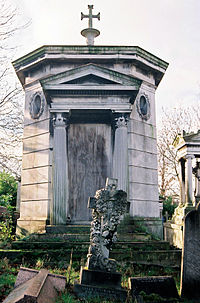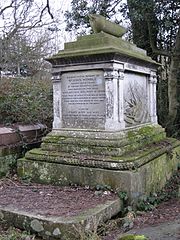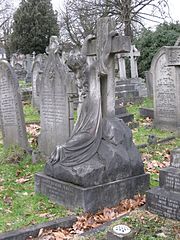West Norwood Cemetery
| West Norwood Cemetery | |
|---|---|
 Gothic inner gates to the cemetery, designed by Sir William Tite | |
 | |
| Details | |
| Established | 1837 |
| Location | Norwood Road, West Norwood, London, SE27 9JU |
| Country | England |
| Coordinates | 51°25′59″N 0°05′55″W / 51.4330°N 0.0986°W |
| Type | Public |
| Owned by | Lambeth London Borough Council |
| Size | 16 hectares (40 acres) |
| No. of graves | 42,000+ |
| No. of interments | around 200,000 |
| Website | Official website |
| Find a Grave | West Norwood Cemetery |
Listed Building – Grade II* | |
| Official name | West Norwood Cemetery & Crematorium |
| Designated | 1 October 1987 |
| Reference no. | 1000851 |
National Register of Historic Parks and Gardens | |
| Official name | West Norwood Cemetery & Crematorium |
| Designated | 1 October 1987 |
| Reference no. | 1000851 |
West Norwood Cemetery is a 40-acre (16 ha) rural cemetery in West Norwood in London, England. It was also known as the South Metropolitan Cemetery. One of the first private landscaped cemeteries in London, it is one of the "
Its grounds are a mixture of historic
Location
The Main gate is located on Norwood Road near the junction with Robson Road, where Norwood Road forks into Norwood High Street and Knights' Hill. It is in the
Site
Believed by some to hold the finest collection of sepulchral monuments in London,

Lambeth Council have recognised it as a site of

It is a mixture of cleared, manicured, and mature landscaping, and includes
Many of these mausolea are
History

The cemetery was founded by its own Act of Parliament of 1836 and consecrated for its first burials in 1837. By 2000, there had been 164,000

As early as 1711,
The new cemetery was consecrated by the Bishop of Winchester on 7 December 1837, receiving its first burial soon after. Until 1877, the consecrated grounds were overseen by the Diocese of Winchester, and then Rochester, before coming under the authority of Southwark from 1905.
Architect William Tite was a director of the cemetery company and designed the landscaping, some monuments, and was eventually interred there himself. This was the first cemetery in the UK to be designed in the new Gothic style. It offered a rural setting in open countryside, as it lay outside London at that time. Its design and location attracted the attention of wealthy – and aspirational – Victorians, who commissioned many fine mausoleums and memorials for their burial plots and vaults.
The site of the cemetery was part of the ancient Great North Wood, from which Norwood took its name. Although many trees had been cleared, a number of mature specimens were included in Tite's original landscaping. A tree survey of the cemetery in 2005 identified one oak which is thought to date from 1540 to 1640. Fourteen more oaks, a maple and an ash tree were identified that predate the foundation of the cemetery in 1836. In the first years of the cemetery's operation, these were joined by coniferous trees and evergreen holm oaks.[4]
Enclosures

In 1842, a section of the cemetery was acquired by London's Greek community for a Greek Orthodox cemetery, and this soon filled with many fine monuments and large mausoleums, memorialising the history of
Another enclosure in the south-east corner was acquired by St Mary-at-Hill in the City of London for its own parish burials.
More recent history
The Dissenters' chapel was damaged by a V-1 flying bomb during World War II and rebuilt in 1956. In 1960 the grand Episcopal chapel was levelled, to be replaced by a memorial rose garden over its catacombs.
The main office at the front of the cemetery was also damaged by another flying bomb; it was rebuilt after the war in a style more sympathetic to its Gothic surroundings.
Between 1978 and 1993, the cemetery achieved several levels of official recognition by being included in the West Norwood Conservation Area, while the entrance arch, the fine railings by
However, space for new burials had largely been exhausted by the inter-war years, and, deprived of this regular source of income, the cemetery company was unable to properly afford its upkeep or the repair of buildings damaged by wartime bombing. Lambeth Council
As a consequence of the courts' findings, Lambeth now operates the cemetery in accordance with a scheme of management under the joint control of all interested parties, that includes Lambeth, the Diocese, the Friends of West Norwood Cemetery and conservation bodies such as Historic England.
Crematorium

While the Anglican catacombs were a popular place for interment, those below the Dissenter's chapel remained largely empty. With the rise of the cremation movement the Cemetery Company identified this as a new source of revenue, and chose to rebuild part of the Dissenters' chapel in 1915 as a crematorium with access from the main hall or/and from the west. A Tousoil Fradet & Cie gas cremator was installed in the basement of the crematorium hall, with its regenerator installed in a vacant portion of the adjacent catacombs. A short length of track led from the basement of the hall into the crematorium for the use of a metal 'introducer' bier. This furnace was augmented over the next few years by two more cremators, designed by the cemetery superintendent Lockwood and the engineering company of Youngs. This equipment is located entirely underground, and used the original Bramah hydraulic lift[6] of the catacombs to lower the coffin from the Crematorium Chapel at ground level, where a 'marshalling yard' of narrow gauge railway track allowed the bier to be moved to the correct furnace. After the war, the Dissenter's chapel was rebuilt in a more modern style as a crematorium, recordia, and columbarium over its catacombs and furnaces.[7] Its equipment has been updated several times, and its cremators are still used on a daily basis. Lambeth Council does not allow publication of images of the crematorium chapel or cremators on any internet website including Wikipedia.
Interments and memorials
A
More than 200 people buried in the cemetery are recorded in the Dictionary of National Biography. The Friends of West Norwood Cemetery have recorded and compiled biographies for many more of these with:
- a large number of inventors, engineers, architects, and builders, such as Sir Hiram Maxim, inventor of the automatic machine gun, Sir Henry Bessemer, engineer and inventor of the famous steel process, James Henry Greathead who tunnelled much of the London Underground, William Burges and Sir William Tite, gothic architects
- many artists and entertainers, including: David Roberts, artist, George Stansbury, actor and acrobat George Conquest, composer and operatic singer, William Collingwood Smith, painter, Joseph Barnby, composer and resident conductor at the Royal Albert Hall, Katti Lanner, ballet dancer, Paul Cinquevalli, juggler and actors O. Smith, E. J. Lonnen, Patsy Smart, Maria Zambaco and Mary Brough
- many notable medics, such as: Dr Eliza Roberts, Florence Nightingale's principal nurse during the Crimean War
- more than twenty Members of Parliament at Lord Mayors of London and a few Australian settler politicians including Sir George Shenton the first Mayor of Perth
- many sportsmen, including Georg Hackenschmidt, Anglo-Russian professional wrestler, and Harry Broome, English bare-knuckle boxing champion
There are also many notables of the time, such as Sir
The Greek diaspora is well represented, including the Ralli family, Panayis Vagliano, Rodocanachi family, Michalinos Family and Princess Eugenie Palaeologue.
Reburials and exhumations
In 1847 some 12,000 remains were taken from the burial vault beneath the Enon Chapel near The Strand, which, after a public health scandal, was bought by George Walker, a prominent surgeon, who had the bodies removed to Norwood Cemetery for reburial in a single mass grave.[9]
In 1969, 11,500 remains were taken from the closed burial ground of St George's, Hanover Square in Bayswater, to West Norwood Cemetery and cremated, for burial here.[10][11]
A Victoria Cross recipient from the
Gallery
West Norwood Cemetery is one of the
-
Entrance gates on Norwood Road leading to the original 1837 gates. On left is Commonwealth War Graves Commission Cross of Sacrifice memorial
-
The Doulton terracotta mausoleum, listed Grade II
-
The John Wimble memorial on Ship Path, grade II
-
The Britton dolmen, grade II*
-
The grave of Sidney Robert Hebert
-
The J.W. Gilbart memorial, grade II
-
Stone ofSir Hiram Maxim
-
Ledger and headstone ofSir Henry Bessemer, grade II
-
Headstone ofMrs Beeton
-
Ceramic mausoleum ofSir Henry Tate, grade II*
-
The iron monument of Grissell on left, grade II, the granite and limestone mausoleum of Alexander Berens by E.M. Barry on right, grade II*
-
Front entrance of crematorium, with access to chapel
-
Wildlife in the cemetery
-
North perimeter wall
-
The memorial rose garden
Cemeteries nearby
- This cemetery 51°25′59″N 0°05′54″W / 51.4330°N 0.0982°W
- Camberwell Old Cemetery 51°27′03″N 0°03′31″W / 51.4508°N 0.0585°W
- Camberwell New Cemetery 51°27′15″N 0°02′52″W / 51.4542°N 0.0477°W
- Nunhead Cemetery 51°27′49″N 0°03′10″W / 51.4636°N 0.0528°W
- Lambeth Cemetery 51°25′39″N 0°10′55″W / 51.4276°N 0.1820°W
- Streatham Cemetery 51°26′01″N 0°10′28″W / 51.4335°N 0.1745°W
Transport
The cemetery is easily reached by public transport:
- Bus: 2, 68, 196, 315, 322, 432, 468 all have stops nearby
- Train: West Norwood railway station is close by
- Underground: Brixton station.
Further reading
- Fenn, Colin R & James Slattery-Kavanagh, West Norwood Cemetery's Greek Necropolis: An Illustrated Guide, FOWNC, 2011, ISBN 1-873520-78-6.
- Fenn, Colin R & James Slattery-Kavanagh, West Norwood Cemetery's Monumental Architecture: An Illustrated Guide to Listed Structures and Builders, FOWNC, 2012, ISBN 1-873520-85-9.
- Manning, Geoffrey, The listed structures in West Norwood Cemetery, Norwood Society, 1989, ISBN 0-9515384-0-3.
- Friends of West Norwood Cemetery (FoWNC), Norwood Cemetery – An Introductory Guide, 2008, ISBN 978-1-873520-65-9.
- Flanagan, Robert, West Norwood Cemetery's Sportsmen, FoWNC, 1995, ISBN 1-873520-09-3
- Flanagan, Robert, West Norwood Cemetery – Music Hall, FoWNC, 1998, ISBN 1-873520-12-3
- Flanagan, Robert, West Norwood Cemetery's Musicians, FoWNC, 1998, ISBN 1-873520-11-5
- Graham, Paul, West Norwood Cemetery: Dickens Connections, FoWNC, 1995, ISBN 1-873520-10-7
- Meller, Hugh & Brian Parsons, London Cemeteries: an illustrated guide and gazetteer, The History Press, 2008, ISBN 978-0-7509-4622-3.
- Beach, Darren, London's Cemeteries, Metro Guides, 2006, ISBN 1-902910-23-0.
References
- ISBN 0-333-57688-8Cemeteries
- ^ English Heritage Register of Parks and Gardens
- ^ It will be enquired, where then shall be the Burials? I answer, in Cemeteries seated in the Out-skirts of the Town... This being inclosed with a strong Brick Wall, and having a Walk round, and two cross Walks, decently planted with Yew-trees, the four-Quarters may serve four Parishes, where the Dead need not be disturbed at the Pleasure of the Sexton, or piled four or five upon one another, or Bones thrown out to gain Room.
Wren, Letter of advice to the Commissioners for Building Fifty New City Churches, 1711 - ^ Friends of West Norwood Cemetery newsletter, No 54. September 2005. Landscape Historical Survey
- ^ Cemetery database of resold plots. Other burials which were not disturbed are not listed.
- ^ "Know Your Norwood- West Norwood Cemetery Catacombs". Norwood Forum: Connecting the Community. Retrieved 15 December 2022.
- ^ "FAQs". West Norwood Cemetery: A New Beginning. Retrieved 15 December 2022.
- ^ CWGC: West Norwood Cemetery and Crematorium
- ^ East London Papers. East London Papers Charitable Trust. 1969.
- ^ Hansard 11 February 1964
- ^ Is This the Skull of Laurence Sterne? The Times 5, 7 & 16 June 1969
External links
- Friends of West Norwood Cemetery
- West Norwood Cemetery Catacombs
- Discovering Britain – West Norwood Walk
- Aerial view from 1933, from the English Heritage "Britain from Above" archive
















